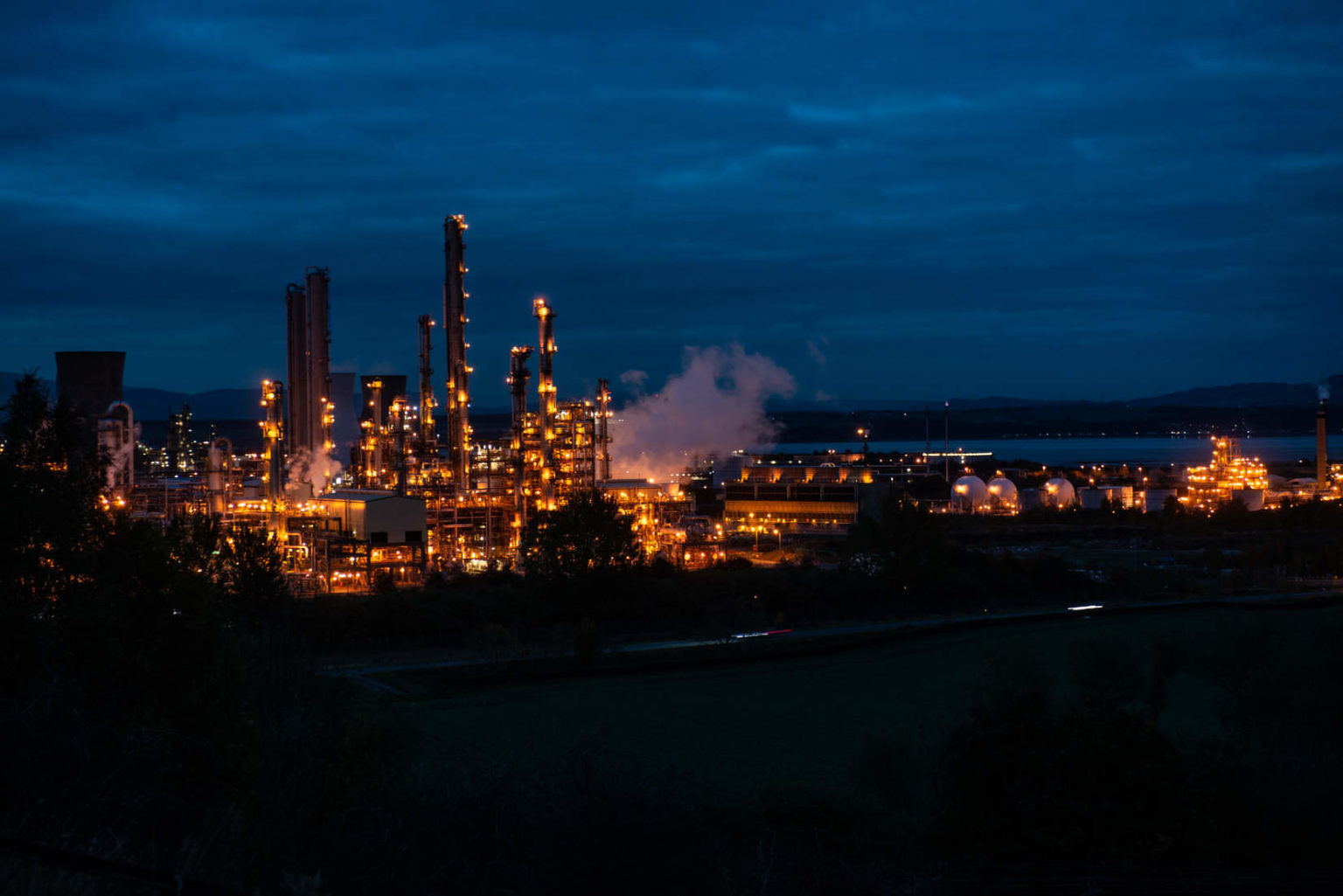In a Scotland straining towards a two-thirds cut in emissions by 2030, the behemoth of Grangemouth represents by far the greatest single obstacle. In addition to the practical questions surrounding its future, it has become totemic for capital, unions, and the Scottish National Party. The prospect of an independent Scotland without a single oil refinery, compelled to re-import its own oil, would be politically unacceptable for Scottish nationalism.
On Tuesday 27 September 2016, to much fanfare on shore, the first tanker loaded with fracked shale gas from Pennsylvania sailed under the Forth Bridges towards the refinery and petrochemical plant at Grangemouth.
This audacious establishment of a “virtual pipeline” was the vital ingredient, according to the site’s owner Jim Ratcliffe, in keeping the plant alive. The precious cargo of shale gas onboard represented the future, the lynchpin of a £450 million “Grangemouth Renaissance” project. It was also a blast from the past.
Though often overlooked, Scotland’s older shale boom, pioneered by James “Paraffin” Young from the 1850s onwards, has left its indelible mark on the landscape near Grangemouth in the form of several flat 150 foot high hills at Winchburgh.
These “West Lothian Alps,” built of burnt shale, are all that remains of an industry that once employed as many as 10,000 people. It was finally snuffed out in 1962, long after the firms that drove its expansion had been subsumed into the Anglo-Persian Oil company; the UK Government concern that would eventually morph into British Petroleum.
In 1924 the beginnings of today’s vast complex at Grangemouth were set up by Anglo-Persian to refine imported Iranian crude oil, close to the town’s ample docks.
“There’s quite a few descendants of the West Lothian shale miners in the town to this day,” says local historian Maureen Burns.
What began with shale, will end with shale. But Grangemouth’s capacity for transitioning its workforce across industries is impressive. In its way as much of a cradle of the industrial revolution as Manchester or Glasgow (the world’s first steamship, the Charlotte Dundas was launched here in 1803), the town is that rarest of things in central Scotland — an industrial centre not burdened with the prefix “post”.
Image: Maureen Burns
Forth and Clyde
The foundations of this success, as Maureen points out, are the docks themselves, which rapidly developed with the completion of the Forth and Clyde canal in 1790, a landmark project linking Scotland’s east and west coasts:
“The canal started the expansion of the dock, the docks themselves adapted from a labour intensive workforce to a container port, the container port needs transport infrastructure, and we’ve got all that,” she explains.
The names of the manufactures drawn here over the years: Carron Ironworks, the Scottish Wholesale and Cooperative Society Soapworks, and Imperial Chemicals Industry (to name just a few) add up to an impressive industrial heritage for a town of around 18,000 inhabitants.
For Maureen, a former ICI employee who oversees a treasure trove of artefacts and photographs at Grangemouth Heritage Trust, this has bred a characteristic resilience in the local workforce down the centuries:
“They’re very flexible and they’re adaptable and I think that’s been the key to the success of all the industries that have taken root in the town.”
However, when Jim Ratcliffe’s multinational petrochemical firm Ineos took charge of Grangemouth in 2005, the workforce at the plant was reluctant to adapt to his new regime.
The tycoon’s 2018 biography, The Alchemist, is quick to identify “traditional union culture dominating the Grangemouth refinery site,” as one of the greatest challenges faced down during his troubled takeover of the plant from BP.
Ratcliffe, who is chairman, CEO and majority shareholder of Ineos, is also the richest person in the UK. His lifestyle — as evidenced by his luxury yacht and recent relocation to Monaco — and his financier’s swagger, illustrated by his decision to move Ineos’s HQ to Switzerland to avoid tax in 2010,could not have added up to a greater culture shock for a company town, shaped by the old paternal corporate ethos of BP.
Far from considering energy transition, or even “greenwashing” its business like BP or Shell, Ineos has lobbied tirelessly for the expansion of fracking in Scotland, securing licenses across the Forth Valley surrounding its citadel. Despite Scottish Government support for investment in Grangemouth and a recent extension of its license, Ineos mounted a legal battle against the devolved administration’s “effective ban” on fracking, which it subsequently lost.
Ratcliffe is used to getting his way, “The concept of owning a business and not being in full control of it was alien to Jim,” explained Tom Crotty, former CEO at the refinery.
In this context, the great PR spectacle of ships from Pennsylvania emblazoned with “Shale Gas for Manufacturing” sailing up the Forth past the Scottish capital, could scarcely be less subtle. Grangemouth, which accounts for around four percent of GDP and a huge proportion of the Scottish chemicals industry, has seen its future tied to shale. Any transition from this feedstock over the coming decades seems destined to be tumultuous.
Norman Phillip
Grangemouth
The site boasts a combined heat and power plant of its own capable of powering a small city. The enormous scale of this vast array of vents, pipes, gas crackers, flares and cooling towers, dwarfs the small town it calls home. At night, lit up by innumerable specks of halogen, it can be seen for miles around.
Given the size and strategic importance of Grangemouth, a facility that was still partly nationalised up to 1987, a dramatic confrontation with Unite the Union and Ineos seemed inevitable.
The terms of the major showdown that took place in October 2013 were already outlined after Unite won a dispute over pension rights for new workers in 2008. The victory was seen as a reassertion of trade union muscle: taking the plant offline during the two-day strike resulted in 70 oil platforms in the North Sea having to shut down or reduce production.
But it turned out to be a hollow victory. In 2013, Ratcliffe adeptly chose his moment to reassert control. A complex chain of events began with a scandal surrounding the selection of a local Labour Party candidate. This then resulted in a threatened 48 hour walk-out by Unite members over the treatment of Unite convener and Grangemouth employee at the heart of the furore, Stephen Deans.
Saved by 11th hour talks and intervention from both the Scottish and UK governments, the dispute culminated in Ratcliffe ordering the permanent closure of the petrochemicals plant, which was shut down along with the refinery.
In the end, Ratcliffe’s brinkmanship paid off, and a chastised Unite agreed to a “survival plan”, entailing an end to workers’ final salary pensions, job cuts, a wage freeze and harsher redundancy terms. In exchange Ineos committed hundreds of millions in new facilities to process ethane from US shale gas.
The defeat for the union, which had to agree to a no strike policy in return for an end to the lockout, was crushing. Last year, collective bargaining rights were withdrawn entirely by Ineos and have only recently been resorted.
Image: West Lothian Alps
The Heart of Oil and Gas
Grangemouth may be the “heartbeat” of Scottish manufacturing and oil production as its owner claims. Certainly, it is the greatest single organ that regulates and sustains the flow of oil and gas around Scotland.
With Ineos’s recent purchase of the Forties pipeline system, almost 40% of North Sea oil supplies, around 70% of the petrol used at Scottish filling stations, and a sizeable chunk of the nation’s manufacturing base, are now controlled by one man.
Throughout the 2013 dispute, Ineos made it clear that they were prepared to walk away from the site. Combining the carrot of new investment with the stick of thousands of job losses, the potent political leverage that ownership of the plant provides was flaunted for all to see.
Since then, as John McNally, the current CEO at the plant has claimed: ‘It’s moved to the premier league.” For the first time in years, Grangemouth is running at full capacity, driven by US shale gas ethane. If a just transition programme were to pose a credible threat to this new profitability, there is no reason to presume that the tactics used in 2013 would not be deployed once again.
For community worker and environmentalist Norman Phillip, there is one crucial interest missing from such debates — the community itself.
Looking out at the plant near where North Sea oil comes ashore at Kinneil he explains:
“The local community get annoyed when people do what we’re doing now: turn cameras onto the oil industry and say “this is Grangemouth.” Because this behind me is a factory and the community, the people, is the town of Grangemouth.”
“And I think that’s what a lot people forget now. Grangemouth is seen as the place where polluting companies can come, Ineos is looking at fracking three miles from here, which, if they got their way, would be drilling under people’s houses and again that’s seen as, ‘well that just fits into the Grangemouth environment’” .
“The community of Grangemouth are fed up being the dumping ground of the nation.”
Other more positive factors, such as a solid base of local contractors, an enviable location and excellent transport links, act as a draw too. The town, uniquely in Scotland, has a public warning system, always ready to be used in the event of a major incident, such as the accidental release of toxic chemicals.
However, the sense of a prosperous community tied to one large employer is no longer present. Where once BP would send recruiters round to local schools in search of apprentices, the focus now is on graduate employment.
“What we’re finding more and more because of the level of the jobs, that most of the workers don’t live in Grangemouth any longer,” says Norman.
Added to this more troubled picture is the fact that the small town now has four areas of multiple deprivation, overlooked by this great sprawl of industry, living with constant noise and intermittent flaring and vibrations. It is still a town shaped by working to shift patterns required by hydrocarbon production, a town where it never really gets dark.
All photos credit: Alan McCredie (c)
Subscribe to our newsletter
Stay up to date with DeSmog news and alerts










